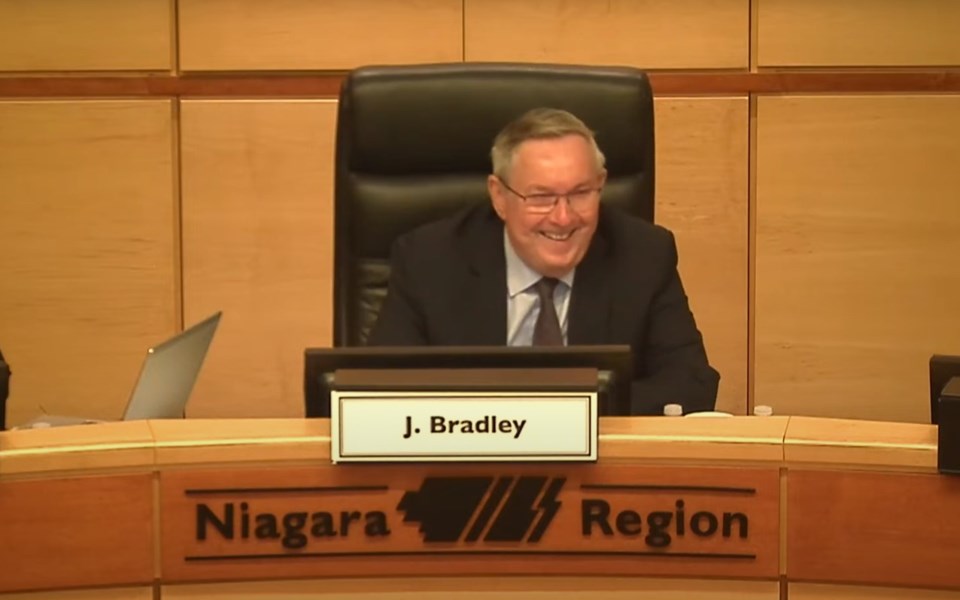Niagara Regional council is pushing the province on two matters after separate motions were brought forward at last week’s regular meeting — one of them requiring a vote of Chair Jim Bradley to break a tie.
A motion brought forward by St. Catharines Regional Coun. Haley Bateman was called “redundant” several times by other members — the first from Welland Mayor Frank Campion who said he “wouldn’t allow it” in his council.
Bateman authored the motion and gave notice to regional council before Premier Doug Ford decided to backtrack on plans to use the Greenbelt for housing development.
In a bombshell report released in early August, Ontario auditor-general Bonnie Lysyk found that Doug Ford’s government gave “preferential treatment” to prominent developers during last year’s controversial changes to the Greenbelt.
There were 15 recommendations given in that report, and at the time Ford said the government would follow 14 of them, but changed his tune in late September and announced all of them will be followed and that the controversial $8.2-million land swap would be cancelled.
Bateman’s motion aims to urge the province to re-evaluate the 2022 decision to change the Greenbelt boundaries.
Campion said it was a “good motion when it was first brought forward,” but argued during last week’s regional council meeting that it was no longer relevant.
On Oct. 16, Municipal Affairs and Housing Minister Paul Calandra introduced legislation to reverse the provincial government’s removal of land from the Greenbelt.
Bateman said that since Ford first announced his government would lay off the Greenbelt and its agricultural land for residential development, “no changes have been made,” and that regional council and Niagara politicians shouldn’t just “trust” that the plan will be reversed.
“This is not how business should be done in politics,” she said.
Lincoln Regional Coun. Rob Foster said the regional government needs to “work with whatever stripe of government” is in power, and that there is “no benefit” to the region sending a resolution to the province on this matter.
“It’s not in our wheelhouse and frankly, I think we should be staying out of it,” he said, adding that it’s up to the official opposition at Queen’s Park to call out the current government and “hold their feet to the fire.”
Niagara Falls Regional Coun. Joyce Morocco agreed the motion might be redundant, but supported it.
“Sometimes you have to poke the bear to get some action,” said Morocco.
Niagara-on-the-Lake Lord Mayor Gary Zalepa said his municipality has received a letter from the housing minister on this matter and would be reviewing it with his council.
“That’s the manner I’ll be giving feedback,” said Zalepa. “I think the minister really is interested in getting the municipal perspective, which I think was missing in the past.”
Andrea Kaiser, regional councillor for NOTL, said there was “no reason” not to support Bateman’s motion, citing the Greenbelt’s importance to Niagara.
After a recorded vote, council was at a standstill — which was broken by Chair Jim Bradley, who supported the motion from Bateman.
“I suppose this could be seen as an endorsement of what the government is doing, so I’ll vote in favour,” Bradley used as his rationale for supporting Bateman’s motion.
Another motion brought to the table by Pelham Regional Coun. Diana Huson has also sent Niagara politicians knocking on the door at Queen’s Park, asking for answers about compensation the province previously said it would give to municipalities negatively impacted by Bill 23, part of the government’s plans to see 1.5 million new homes built by 2032.
Huson’s motion says Niagara’s losses are an anticipated 20 per cent reduction in development charge rates, which adds up to $35 million over the next five years.
That will cause a loss of $60 million over 10 years from the capital plan, which is set aside to address social housing, she added.
Huson’s calculations show losses from Bill 23 are 2.5 per cent of a potential nine-per-cent increase in regional property taxes.
The province said in late August that only communities with housing targets will have access to the $1.2 billion Building Faster Fund, Huson included in her motion.
Upper-tier municipalities such as Niagara were not assigned housing targets, “even though we play a significant role in providing some of the necessary infrastructure to support those housing targets,” she said at last week’s meeting.
Huson’s motion was approved unanimously.




